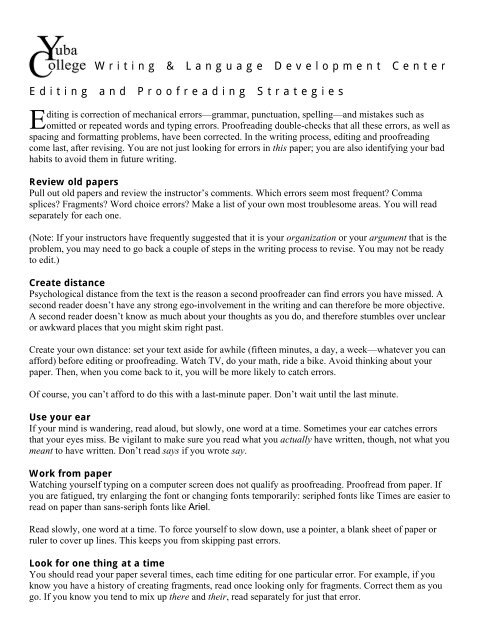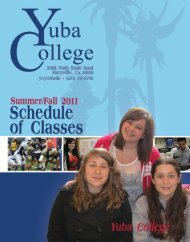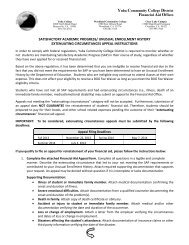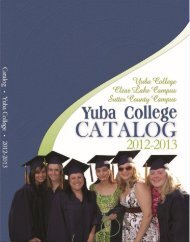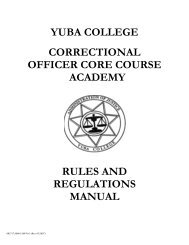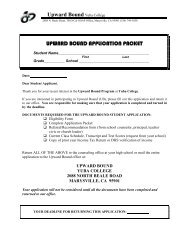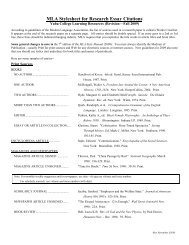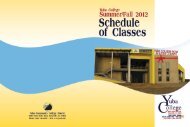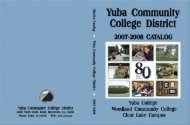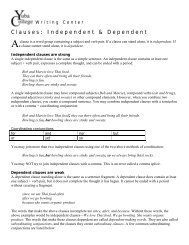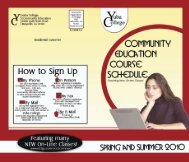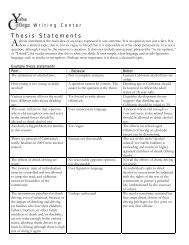Writing & Language Development Center Editing and Proofreading ...
Writing & Language Development Center Editing and Proofreading ...
Writing & Language Development Center Editing and Proofreading ...
You also want an ePaper? Increase the reach of your titles
YUMPU automatically turns print PDFs into web optimized ePapers that Google loves.
<strong>Writing</strong> & <strong>Language</strong> <strong>Development</strong> <strong>Center</strong><strong>Editing</strong> <strong>and</strong> <strong>Proofreading</strong> Strategies<strong>Editing</strong> is correction of mechanical errors—grammar, punctuation, spelling—<strong>and</strong> mistakes such asomitted or repeated words <strong>and</strong> typing errors. <strong>Proofreading</strong> double-checks that all these errors, as well asspacing <strong>and</strong> formatting problems, have been corrected. In the writing process, editing <strong>and</strong> proofreadingcome last, after revising. You are not just looking for errors in this paper; you are also identifying your badhabits to avoid them in future writing.Review old papersPull out old papers <strong>and</strong> review the instructor’s comments. Which errors seem most frequent? Commasplices? Fragments? Word choice errors? Make a list of your own most troublesome areas. You will readseparately for each one.(Note: If your instructors have frequently suggested that it is your organization or your argument that is theproblem, you may need to go back a couple of steps in the writing process to revise. You may not be readyto edit.)Create distancePsychological distance from the text is the reason a second proofreader can find errors you have missed. Asecond reader doesn’t have any strong ego-involvement in the writing <strong>and</strong> can therefore be more objective.A second reader doesn’t know as much about your thoughts as you do, <strong>and</strong> therefore stumbles over unclearor awkward places that you might skim right past.Create your own distance: set your text aside for awhile (fifteen minutes, a day, a week—whatever you canafford) before editing or proofreading. Watch TV, do your math, ride a bike. Avoid thinking about yourpaper. Then, when you come back to it, you will be more likely to catch errors.Of course, you can’t afford to do this with a last-minute paper. Don’t wait until the last minute.Use your earIf your mind is w<strong>and</strong>ering, read aloud, but slowly, one word at a time. Sometimes your ear catches errorsthat your eyes miss. Be vigilant to make sure you read what you actually have written, though, not what youmeant to have written. Don’t read says if you wrote say.Work from paperWatching yourself typing on a computer screen does not qualify as proofreading. Proofread from paper. Ifyou are fatigued, try enlarging the font or changing fonts temporarily: seriphed fonts like Times are easier toread on paper than sans-seriph fonts like Ariel.Read slowly, one word at a time. To force yourself to slow down, use a pointer, a blank sheet of paper orruler to cover up lines. This keeps you from skipping past errors.Look for one thing at a timeYou should read your paper several times, each time editing for one particular error. For example, if youknow you have a history of creating fragments, read once looking only for fragments. Correct them as yougo. If you know you tend to mix up there <strong>and</strong> their, read separately for just that error.
To catch spelling or word choice errors, read each word individually from the end of each line to thebeginning. Computer spell checkers won't catch sound-alikes such as they're, their, <strong>and</strong> there, or errors suchas typing he for the. (Spell checkers are interactive. You have to choose the right word each time it stops.There’s no getting around it—you have to learn the difference between were <strong>and</strong> where. A grammarh<strong>and</strong>book or dictionary can help.)If you confuse plurals <strong>and</strong> possessives, skim looking only for words that end in s. If a word ends in sbecause it is plural, there should be no apostrophe: If the word indicates possession or is a contraction oftwo words, it needs an apostrophe. Its (the radio station is holding its fundraiser) is analogous to his orhers—no apostrophe.If you tend to make errors in subject-verb agreement, go through one sentence at a time <strong>and</strong> identify thesimple subject <strong>and</strong> main verb in each. Do the subjects <strong>and</strong> verbs go together? You can’t write, “Expertssays” or “Everybody know.”For pronoun problems, skim line by line <strong>and</strong> stop at each pronoun. Find the noun that the pronoun replaces.If you can't find it within the sentence, or at most within a sentence or two preceding, replace the pronounwith a noun. If you find the noun the pronoun refers to, but there are other nouns nearby <strong>and</strong> it might beunclear (not to you, but to a reader) which you’re talking about, replace the pronoun with a noun. Be sureevery noun agrees in number <strong>and</strong> person with its corresponding pronoun. Look especially for they, their,<strong>and</strong> them—they are plural pronouns <strong>and</strong> must refer to plural nouns. Anyone, everyone, <strong>and</strong> everybody aresingular. You can’t write, “Everybody has their books.”Fragment errors are sometimes heard better than seen. Read your paper aloud. Stop at every period <strong>and</strong> takea breath; can your ear find the fragments? Pay special attention to sentences that begin with subordinatingwords, such as because, if, or when. Watch for phrases like for example or such as or phrases starting with –ing adjectives (participles). Decide if a fragment might be just a piece of the previous or next sentence thatmistakenly got separated by a period. If so, connect it to the independent clause. Otherwise, add the missingsubject or verb or remove the subordinating conjunction.Run-on sentences are not merely long sentences; run-ons are punctuated wrongly. In particular, a solitarycomma is not allowed to join two independent clauses. If you tend to create these comma splices, start withthe last sentence of your paper <strong>and</strong> work your way back to the beginning, stopping at every comma. Is therean independent clause on both sides of the comma? If there is, the comma must be accompanied by acoordinating conjunction or replaced by a semicolon or a period.An omitted comma can result in another kind of run-on. To find omitted comma errors, skim for theconjunctions <strong>and</strong>, but, for, or, nor, so, <strong>and</strong> yet. See whether there is a complete sentence on each side of theconjunction. If there is, place a comma before the conjunction.To find introductory comma errors, read the first two or three words of each sentence. Look for subordinateconjunctions such as because or when; transition words such as nevertheless or however; participial phrasessuch as serving four years in the Navy; or prepositional phrases such as in contrast or about two years ago.Place a comma at the end of the introductory word, phrase or clause, <strong>and</strong> before the independent clause.Awkwardness results from parallel structure errors. Find these by skimming for key words that signalparallel structures: <strong>and</strong>, or, not only...but also, either...or, both...<strong>and</strong>…. Make sure that the items connectedby these words are in the same grammatical form: golf, basketball, <strong>and</strong> soccer is parallel; golf, basketball,<strong>and</strong> to play soccer is not.


